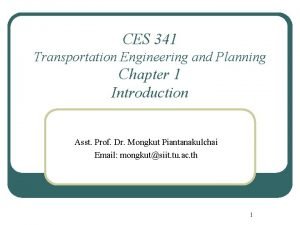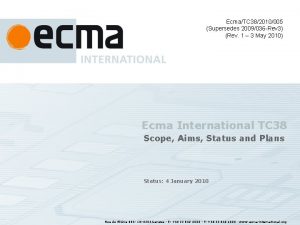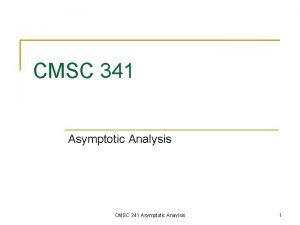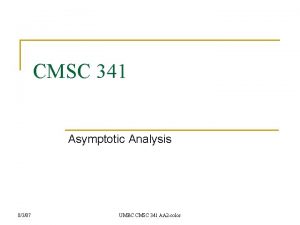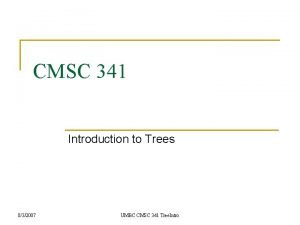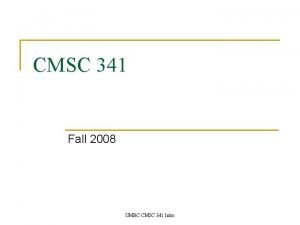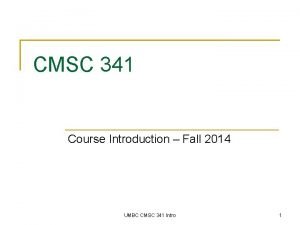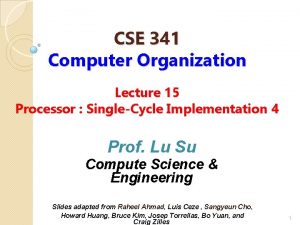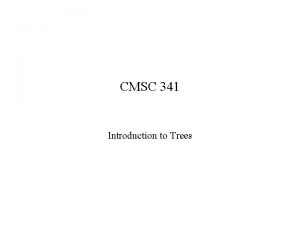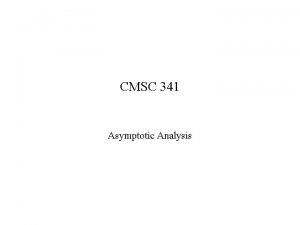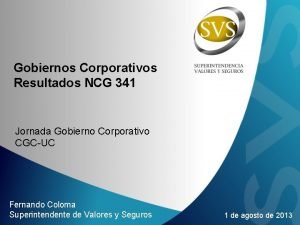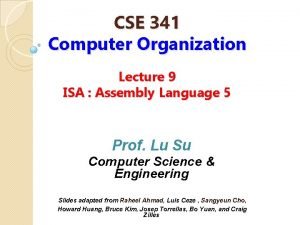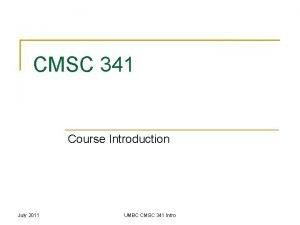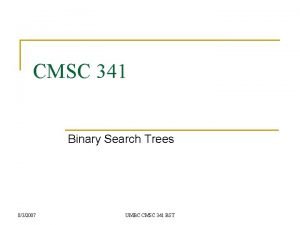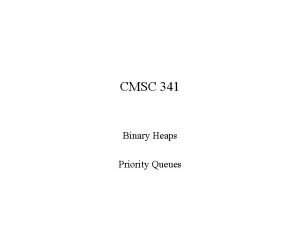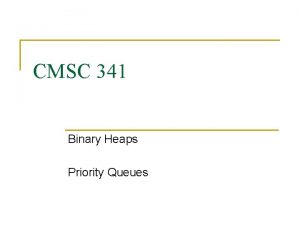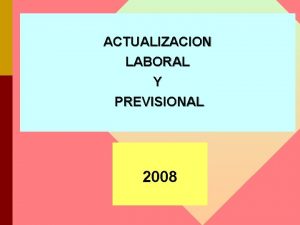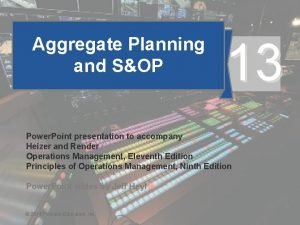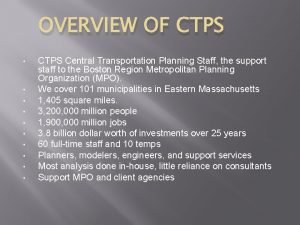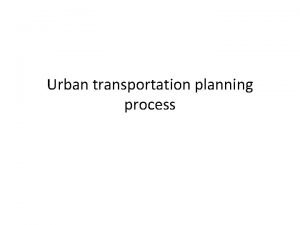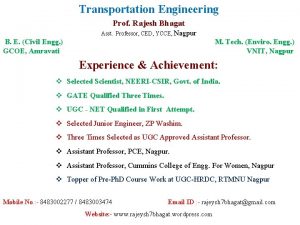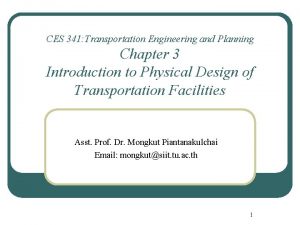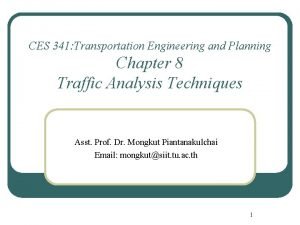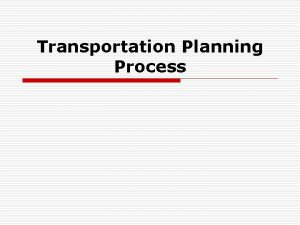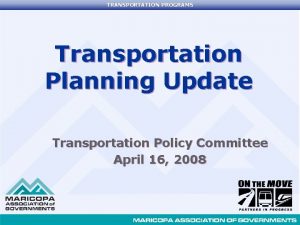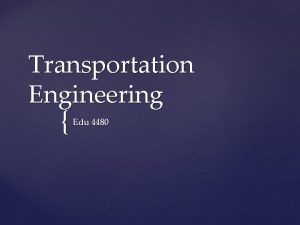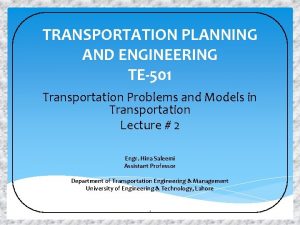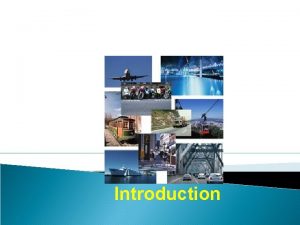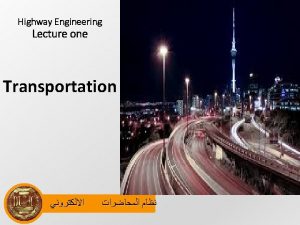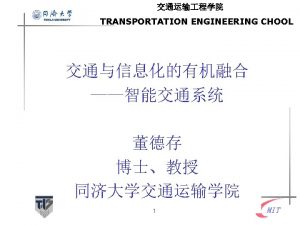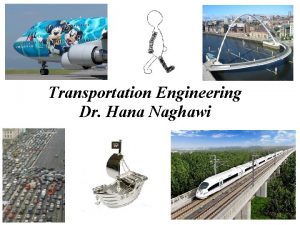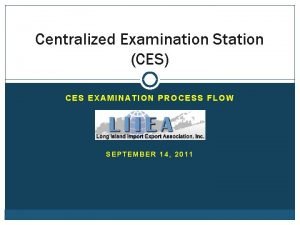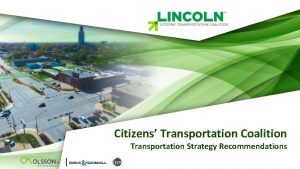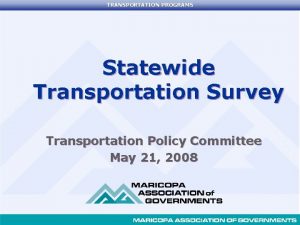CES 341 Transportation Engineering and Planning Chapter 2



























- Slides: 27

CES 341: Transportation Engineering and Planning Chapter 2 Transportation System Issues and Challenges Asst. Prof. Dr. Mongkut Piantanakulchai Email: mongkut@siit. tu. ac. th 1

The Challenges in Transportation 1. 2. 3. 4. 5. 6. 7. Managing congestion Directly Improving safety related to transportation Providing equal access system itself Protecting the environment Related to Incorporating new technology transport Securing financial resources engineering profession, Developing adequate institutional arrangements CES 341 Transportation Engineering and Planning economic, political system Chapter 2: Transportation System Issues and Challenges 2

2. 1 Traffic Congestion l l l Some solutions to traffic congestion Expanding facilities (supply) Intelligent traffic control Better urban land use planning Demand management • • Economic incentives – congestion pricing Priority for high-occupancy-vehicle (HOV) Challenge: combination of supply & demand measures CES 341 Transportation Engineering and Planning Chapter 2: Transportation System Issues and Challenges 3

2. 2 Traffic Safety 2. 2. 1 Trend l l Decreasing of fatality rate in US Traffic accident problem in developing countries (e. g. Thailand, China, India( CES 341 Transportation Engineering and Planning Chapter 2: Transportation System Issues and Challenges 4

2. 2 Traffic Safety 2. 2. 2 Organizational Responsibilities l USDOT l How about Thailand? • FHWA • FAA • FRA • NHTSA • NTSB CES 341 Transportation Engineering and Planning Chapter 2: Transportation System Issues and Challenges 5

2. 2 Traffic Safety 2. 2. 3 Legal Concerns l Tort liability of traffic accidents • “Liability for damages in cases where unsafe conditions lead to personal injury or property damages” l Ministerial functions and discretionary functions CES 341 Transportation Engineering and Planning Chapter 2: Transportation System Issues and Challenges 6

2. 2 Traffic Safety 2. 2. 3 Legal Concerns l Declines of 2 doctrines • Doctrine of sovereign immunity (government • cannot be sued without its consent) Doctrine of contributory negligence (plaintiff cannot recover for damages if they share responsibility for the accident, even if it can be shown that another party was primarily at fault) Changed to doctrine of comparative negligence (negligence is allocated by the court based on a percentage basis) CES 341 Transportation Engineering and Planning Chapter 2: Transportation System Issues and Challenges 7

2. 2 Traffic Safety 2. 2. 3 Legal Concerns l l l Rise of • The doctrine of joint and several liability (“deep pockets”) doctrine – public agencies bear most of the cost of the settlement even if the degree of responsibility is minor Responses from transportation agencies • Risk management program to limit exposure to liability • • Instituting Accident reduction programs Training of personnel involved in tort cases Transfer risk to other parties (ex. Indemnity clauses in contracts) Challenge: Increase of public expectations, trade-off public measures, law & politics, personal freedom, how to reduce accident while more traffic CES 341 Transportation Engineering and Planning Chapter 2: Transportation System Issues and Challenges 8

2. 3 Equality of Access l Provide equal access to l The poor • The poor • The elderly • The physically handicapped • Can’t afford to own automobiles • Mass-transit system normally trying to compete with auto – put more incentives to choice riders rather than captive riders CES 341 Transportation Engineering and Planning Chapter 2: Transportation System Issues and Challenges 9

2. 3 Equality of Access l The elderly and the physically handicapped • • • Unable to operate automobiles Barriers to the use of public transportation ADA – design standards for access by disabled (ADAAG): all public transportation systems must be fully accessible to both wheelchair users and pedestrians • • • Installation of wheelchair lifts on public transit vehicles Provision of curb cuts and wheelchair ramps at intersections of streets with sidewalks Provision of wheelchair access by means of ramps or elevators at facilities such as airports and rail transit stations CES 341 Transportation Engineering and Planning Chapter 2: Transportation System Issues and Challenges 10

2. 3 Equality of Access l Challenges • More stringent accessibility standards/ design • Financing of accessibility features (ex. • modifications of mass transit vehicles and mass transit stations) Sometimes conflicts with safety standards CES 341 Transportation Engineering and Planning Chapter 2: Transportation System Issues and Challenges 11

2. 4 Environmental Protection 2. 4. 1 Site-Specific Impacts l l Site-specific impacts: Relocation of residents and business due to construction, noise, wildlife, water quality, visual impacts, temporary impacts during construction Environmentally sensitive areas: habitats of endangered species, flood plains, wetlands, coastal zones, prime agricultural lands, historical sites, wild/scenic rivers CES 341 Transportation Engineering and Planning Chapter 2: Transportation System Issues and Challenges 12

2. 4 Environmental Protection 2. 4. 1 Site-Specific Impacts l l In the US, the site-specific environmental impact due to transportation system is regulated by the process of documenting “environmental impacts” Under National Environmental Policy Act of 1969 (NEPA), a document called Environmental Impact Statement (EIS) is needed to be prepared CES 341 Transportation Engineering and Planning Chapter 2: Transportation System Issues and Challenges 13

2. 4 Environmental Protection 2. 4. 2 System-Level Impacts l l System-level impacts: air quality, energy consumption, land use Transportation-related energy consumption concern • • l Magnitude – 50 percent of all energy consumed (direct + indirect) Source of energy – mainly petroleum Sharp rise of petroleum price: “Energy crises” CES 341 Transportation Engineering and Planning Chapter 2: Transportation System Issues and Challenges 14

2. 4 Environmental Protection 2. 4. 2 System-Level Impacts l Major thrust via energy public policies • Develop improved vehicle technologies – gasoline • • mileage standards, incentives to improve technology Develop new fuels that substitute for petroleum – gasohol, bio-diesel, etc. , research, tax incentives Political measures to secure petroleum supply – Gulf War in 1991 CES 341 Transportation Engineering and Planning Chapter 2: Transportation System Issues and Challenges 15

2. 4 Environmental Protection 2. 4. 2 System-Level Impacts l l l Air pollution: Major concern, use of highway vehicles in densely populated metropolitan areas Impacts: Brown smog, ozone levels, NOX, CO 2 (Global warming) Clean Air Act Amendments 1970, 1977, 1990 focuses on • • l Vehicle technology – emission control devices Vehicle maintenance – vehicle inspection Successful to reduce emission rate (emission/VMT) but offset by the growth of VMT CES 341 Transportation Engineering and Planning Chapter 2: Transportation System Issues and Challenges 16

2. 4 Environmental Protection 2. 4. 2 System-Level Impacts l Policy related to planning level • State Implementation Plans (SIPs) for individual air basin within states • Air basins by air quality standards • Nonattainment areas – standards are not met • Maintenance areas – standards are met • Sanctions (withholding of federal highway funds) may be imposed for failure to prepare plans or to implement them CES 341 Transportation Engineering and Planning Chapter 2: Transportation System Issues and Challenges 17

2. 5 New Technology l l Adjustment of the transportation system to new technology is a constant challenge New vehicular technology, or system concept (containerized freight shipping) CES 341 Transportation Engineering and Planning l l l Stream ship and railroad: early 1800 s Automobile: end of 1800 s Airplane: early 1900 s Chapter 2: Transportation System Issues and Challenges 18

2. 5 New Technology: ITS l Intelligent Transportation System (ITS): previously Intelligent Vehicle and Highway System (IVHS) CES 341 Transportation Engineering and Planning l Intelligent Transportation Society of America (ITS America) Chapter 2: Transportation System Issues and Challenges 19

2. 5 New Technology: ITS User Services l l l l Travel and transportation management Travel demand management Public transportation operations Electronic payment services Commercial vehicle operations Emergency management Advanced vehicle control and safety systems CES 341 Transportation Engineering and Planning Chapter 2: Transportation System Issues and Challenges 20

2. 5 New Technology: ITS by functional systems l Advanced Traffic Management and Information Systems (ATMIS) • Advanced Traffic Management Systems (ATMS) • Advanced Traveler Information Systems (ATIS) l Advanced Vehicle Control Systems (AVCS) CES 341 Transportation Engineering and Planning Chapter 2: Transportation System Issues and Challenges 21

Copyright © The Mc. Graw-Hill Companies, Inc. Permission required for reproduction or display. 341 Transportation. System Architecture Chapter 2: Transportation System Issues and 2 -2 ITSCES Top-level Engineering and Planning Challenges 22

2. 6 Funding: Securing adequate financial resources l Public agencies: not adequate transport finance drawn from general funds – competitive with other needs • Separate from general funds: Fuel taxes – sometimes not so effective • Toll financing – for expensive facilities, make higher cost • Special financing programs – revenue bonds l Private firms: granted franchise to operate, can access larger capital sources CES 341 Transportation Engineering and Planning Chapter 2: Transportation System Issues and Challenges 23

2. 6 Funding: Other problems l Increasing costs – construction costs, litigation costs (tort law), maintenance costs, environmental mitigation costs l Low number of passengers – example: scheduled transpiration services • Airline – responds by price discrimination strategy to • l increase revenue Government services: price regulation – create unfair advantage for one mode, ex. trucking and rail Deferred maintenance: increase operating costs and safety problems, ex. railroad CES 341 Transportation Engineering and Planning Chapter 2: Transportation System Issues and Challenges 24

2. 6 Funding: Other problems l Bankruptcies and mergers: ex. Airlines companies after deregulation due to “cutthroat” competition (strong firm sets prices below costs in order to capture a larger market share and drive weaker firms out of the market) CES 341 Transportation Engineering and Planning Chapter 2: Transportation System Issues and Challenges 25

2. 7 Institutional arrangements: Trends l Deregulation: Ex. Airlines, keep only safety regulation • Privatization – some public mass transit operator financial failures due to lack of incentives to operate efficiently • limited privatization (set up fixed fares and schedule, allowing both public and private company to bid for providing service without losing control of fare and level of service) CES 341 Transportation Engineering and Planning Chapter 2: Transportation System Issues and Challenges 26

2. 7 Institutional arrangements: Trends l Overcoming modal and jurisdictional fragmentation • Integration of different modes of transportation – barriers rooted by government regulations • Jurisdictional integration • Arterial signal control systems that cross jurisdictional • • • boundaries Incident management Traffic and congestion monitoring Provision of real time traffic information to public CES 341 Transportation Engineering and Planning Chapter 2: Transportation System Issues and Challenges 27
 341 ces
341 ces Sda hymn 341
Sda hymn 341 Ecma-341
Ecma-341 Cmsc 341
Cmsc 341 Cmsc 341
Cmsc 341 Round the following numbers to the nearest hundreds 625
Round the following numbers to the nearest hundreds 625 Komax 341
Komax 341 Cmsc 341
Cmsc 341 Umbc cmsc 341
Umbc cmsc 341 Cmsc 341
Cmsc 341 Cse 341
Cse 341 Cmsc 341
Cmsc 341 Cmsc 341
Cmsc 341 Xr-341
Xr-341 Oh mon sauveur a toi seul je veux etre
Oh mon sauveur a toi seul je veux etre Mgmt 341
Mgmt 341 Ncg 341
Ncg 341 Cs341 uwaterloo
Cs341 uwaterloo Cse 341
Cse 341 Umbc cmsc 202
Umbc cmsc 202 Cmsc 341 umbc
Cmsc 341 umbc Cmsc 341
Cmsc 341 Cmsc 341
Cmsc 341 Actualizacion 341
Actualizacion 341 Graphical method of aggregate planning
Graphical method of aggregate planning Central transportation planning staff
Central transportation planning staff Urban transportation act of 1964
Urban transportation act of 1964 Transportation engineering
Transportation engineering
